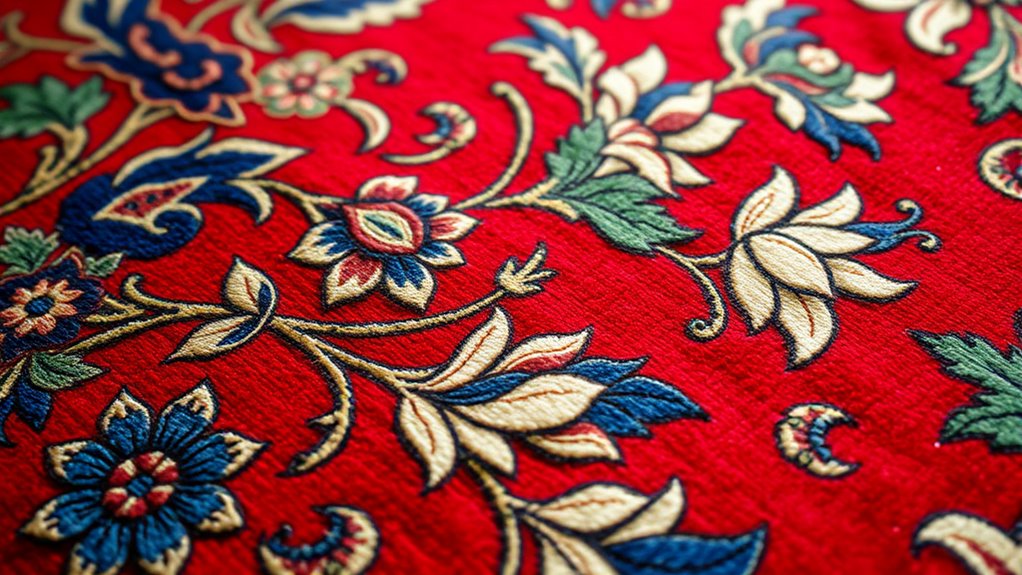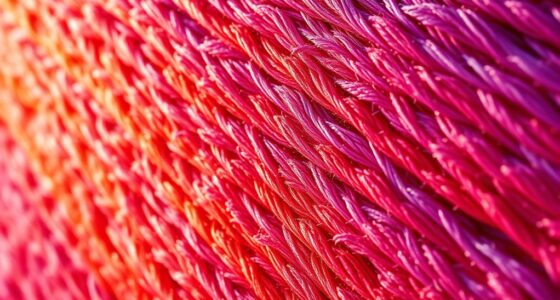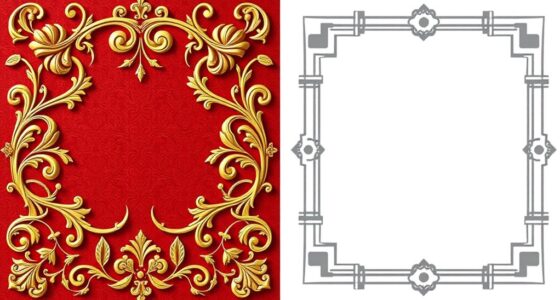To interpret floral motifs in Persian carpets, focus on their symbolism and regional styles. Flowers like roses, lotus, and cypress carry meanings of love, purity, and eternity. Colors also add layers of meaning, reflecting spiritual and cultural values. Pay attention to pattern flow, symmetry, and specific botanical symbols, which reveal deeper cultural, religious, and historical influences. Exploring these details helps you appreciate the intricate stories woven into each design—there’s much more to uncover behind every motif.
Key Takeaways
- Analyze the overall pattern, symmetry, and motif interactions to understand their symbolic meanings and cultural significance.
- Identify specific floral motifs like roses, lotus, or cypress and interpret their traditional symbolic representations.
- Observe color choices and shading techniques, as colors carry spiritual and emotional connotations in Persian floral art.
- Recognize regional styles and variations, which influence the design, symbolism, and craftsmanship of floral motifs.
- Consider the cultural and spiritual context, connecting floral symbols to themes like paradise, renewal, and divine harmony.
The Significance of Floral Patterns in Persian Art

Floral patterns hold a deep cultural and symbolic meaning in Persian art, reflecting the natural beauty and spiritual beliefs of the region. You’ll notice how botanical symbolism is central to these designs, representing concepts like paradise, renewal, and divine harmony. Over time, the floral pattern evolution in Persian carpets reveals a progression from highly stylized motifs to more intricate and naturalistic forms, showcasing artistic refinement. These patterns serve not just decorative purposes but also embody spiritual ideals, connecting the viewer to the divine and the eternal. As you explore Persian carpets, you’ll see how each floral element carries layered significance, illustrating a profound relationship between nature, spirituality, and artistic expression in Persian culture. Additionally, the contrast ratio in the detailed designs enhances the depth and vibrancy of the floral motifs, making each pattern more vivid and engaging to the observer. The incorporation of symbology in these motifs further enriches their cultural importance, conveying stories and beliefs through intricate designs. Moreover, the use of symmetry in these patterns exemplifies the harmony and balance valued in Persian artistic traditions. An understanding of the craftsmanship involved reveals the skill and tradition passed down through generations, further elevating the artistic value of these carpets. Furthermore, the techniques employed in creating these motifs demonstrate the meticulous craftsmanship and dedication of Persian artisans.
Common Floral Motifs and Their Symbolic Meanings
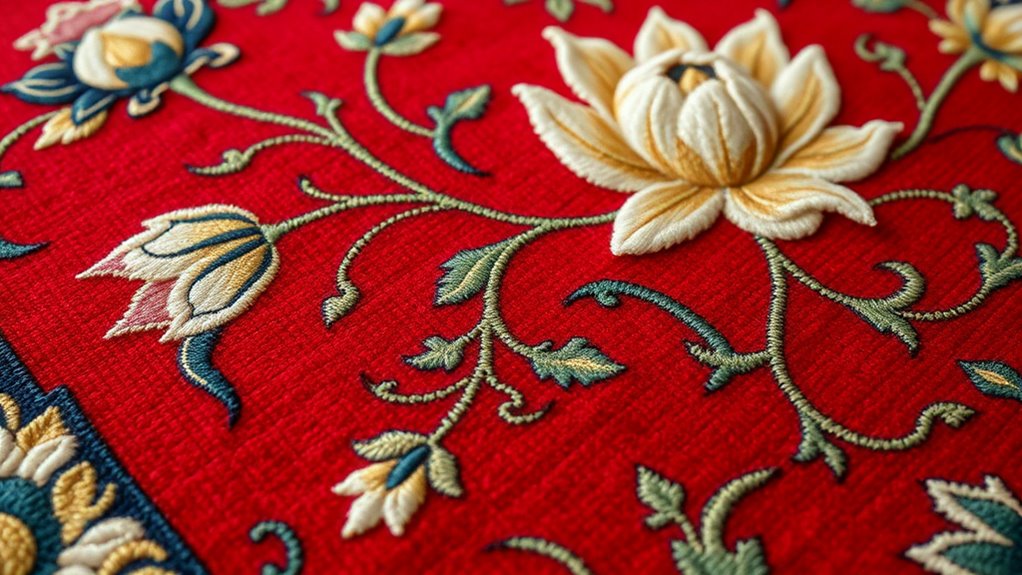
You’ll notice that the rose often symbolizes love and beauty in Persian carpets, representing both spiritual and earthly desires. The lotus, on the other hand, signifies purity and enlightenment, frequently appearing in designs that evoke spiritual growth. Understanding these motifs helps you appreciate the deeper meanings woven into each carpet’s pattern. Incorporating visualization techniques can enhance your ability to interpret complex designs and their symbolic significance. Additionally, recognizing the artistic automation involved in traditional craftsmanship can deepen your understanding of cultural heritage. Recognizing the importance of symbolic language in these motifs allows for a richer appreciation of the artistry behind Persian carpets. Incorporating knowledge of Private Placement Memorandum strategies can also offer insight into how meticulous planning and detailed descriptions contribute to the overall value and authenticity of such art pieces.
Rose Symbolism
The rose holds a special place in Persian carpet art, symbolizing beauty, love, and spiritual growth. Its presence often reflects garden symbolism, emphasizing paradise and divine harmony. As a botanical representation, the rose’s intricate design showcases its significance beyond mere decoration, embodying both earthly pleasures and spiritual aspirations. You’ll notice how artisans depict the rose’s layered petals to evoke depth and vitality, emphasizing its role as a symbol of purity and passion. The recurring motif of the rose connects viewers to themes of renewal and divine love, resonating through Persian cultural and spiritual traditions. Its universal appeal makes it a powerful emblem, inspiring contemplation of beauty and transcendence in every woven pattern. Additionally, the filtration techniques used in the creation of these motifs demonstrate the artisans’ meticulous attention to detail and their desire to imbue each design with symbolic meaning, often reflecting aesthetic harmony and cultural values. The symbolic meanings associated with floral motifs reveal a rich tradition of storytelling and spiritual symbolism woven into each carpet, elevating them beyond decorative art. Moreover, the natural dyes employed in coloring the motifs are carefully selected to enhance their color symbolism, strengthening the connection between the visual design and its spiritual significance. Furthermore, the use of natural dyes in coloring the motifs enhances their symbolic significance by connecting the designs to the natural world and spiritual symbolism.
Lotus Significance
Building on the rich symbolism of the rose, the lotus emerges as another powerful motif in Persian carpet art, carrying its own profound meanings. Lotus symbolism often represents purity, spiritual awakening, and rebirth, reflecting its sacred role in various cultures. As the floral pattern evolution unfolds, the lotus’s elegant form is incorporated into intricate designs, emphasizing harmony and renewal. You’ll notice that the lotus’s stylized petals symbolize enlightenment and the journey toward spiritual transcendence. Its recurring presence in Persian carpets highlights its importance beyond mere decoration, serving as a reminder of divine purity. The lotus’s enduring appeal in carpet motifs underscores its significance as a symbol of hope and spiritual growth, enriching the cultural narrative embedded within these timeless textiles. Additionally, the cultural symbolism involved in designing these motifs involves deep cultural knowledge and artistic skill, ensuring that each piece embodies both beauty and symbolism.
Regional Variations in Floral Design and Interpretation
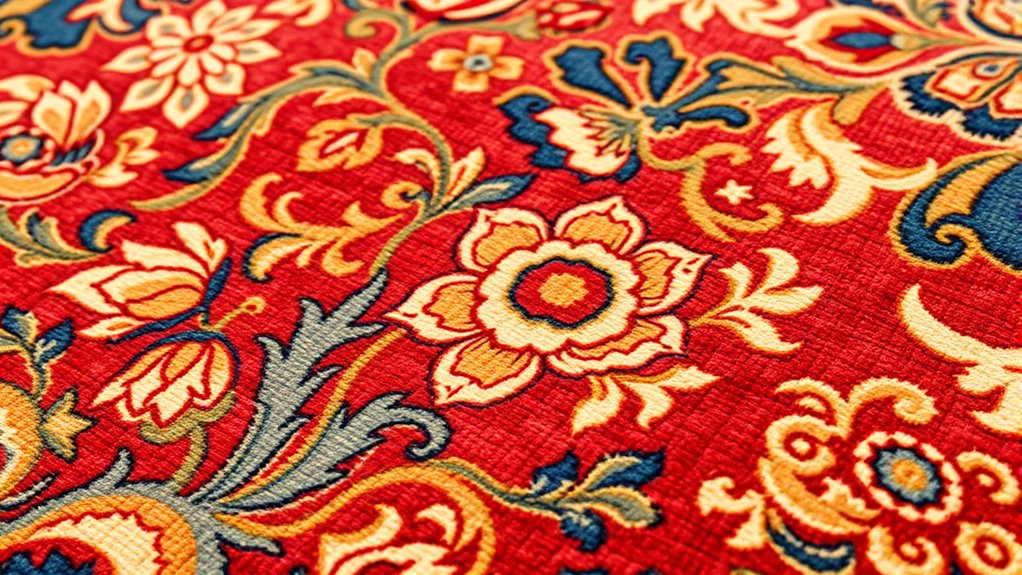
Regional variations in floral design and interpretation reveal how local traditions, climate, and cultural influences shape Persian carpets. You’ll notice differences in regional color schemes, which reflect available dyes and aesthetic preferences, and botanical accuracy, highlighting local flora. For example:
| Region | Floral Characteristics | Interpretation Focus |
|---|---|---|
| Isfahan | Bright colors, detailed floral motifs | Elegance, spirituality |
| Tabriz | Bold, stylized flowers | Power, craftsmanship |
| Kashan | Soft hues, realistic flower depictions | Natural beauty, harmony |
These distinctions showcase how regional styles adapt floral motifs to local environments and cultural values, enriching the carpets’ symbolic meanings. Recognizing the regional diversity in floral motifs enhances appreciation for their cultural significance and artistic craftsmanship.
Historical Influences on Persian Floral Carpet Motifs

You can see how ancient artistic traditions shaped the intricate floral patterns in Persian carpets. Over time, cultural symbolism evolved, adding new layers of meaning to these motifs. Understanding these influences helps you appreciate the rich history embedded in each design.
Ancient Artistic Traditions
Ancient artistic traditions have profoundly shaped the floral motifs seen in Persian carpets, reflecting a deep cultural connection to historical symbolism and craftsmanship. You’ll notice how botanical symbolism influences the designs, with each flower and plant representing specific spiritual or cultural meanings passed down through generations. These motifs are crafted using sophisticated artistic techniques, such as intricate knotting and detailed dyeing, which highlight the skill of Persian artisans. The use of symmetry, stylization, and geometric patterns derives from long-standing artistic practices rooted in ancient Persia. By understanding these traditions, you gain insight into the deeper significance behind each floral motif, recognizing how they embody centuries of cultural expression and artistic mastery that continue to define Persian carpet artistry today.
Cultural Symbolism Evolution
The evolution of cultural symbolism in Persian floral carpets reveals how historical influences have shaped their motifs over centuries. Botanical variations reflect regional and cultural exchanges, influencing the design and meaning behind each motif. Color symbolism also plays a vital role, with specific hues representing concepts like purity, fertility, or spirituality. Over time, motifs adapted to reflect changing beliefs and artistic trends. The table below highlights some common floral motifs and their symbolic meanings:
| Floral Motif | Meaning |
|---|---|
| Rose | Love, beauty |
| Lotus | Spiritual purity |
| Cypress | Eternity, resilience |
| Pomegranate | Fertility, abundance |
| Jasmine | Grace, elegance |
Understanding these shifts helps you appreciate the depth behind each carpet’s design and cultural significance.
Techniques Used to Depict Flowers and Their Artistic Implications
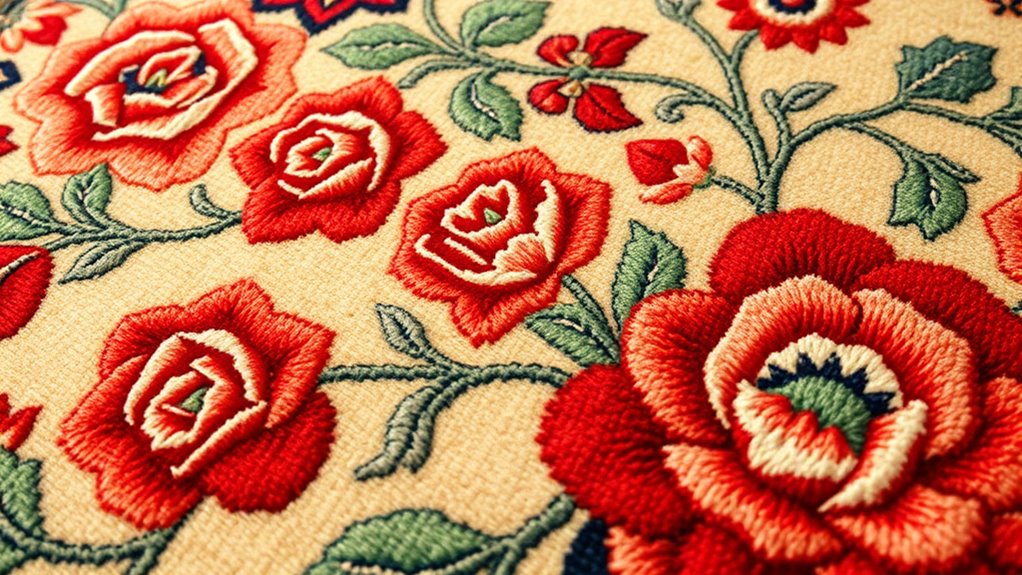
Artists employ a variety of techniques to depict flowers in Persian carpets, each serving to enhance their symbolic and aesthetic significance. They often aim for botanical realism, carefully shaping petals and leaves to resemble real flowers, which adds depth and authenticity to the design. Color symbolism also plays a crucial role; vibrant hues like red, blue, and gold convey specific meanings, such as passion, spirituality, or prosperity. To achieve these effects, artisans use precise shading and detailed outlines, ensuring the flowers stand out and evoke emotional responses. These techniques not only highlight the skill involved but also deepen the viewer’s understanding of the motifs’ cultural importance. Ultimately, the combination of realism and color symbolism elevates the artistic impact of floral depictions in Persian carpets.
The Role of Floral Motifs in Cultural and Religious Contexts
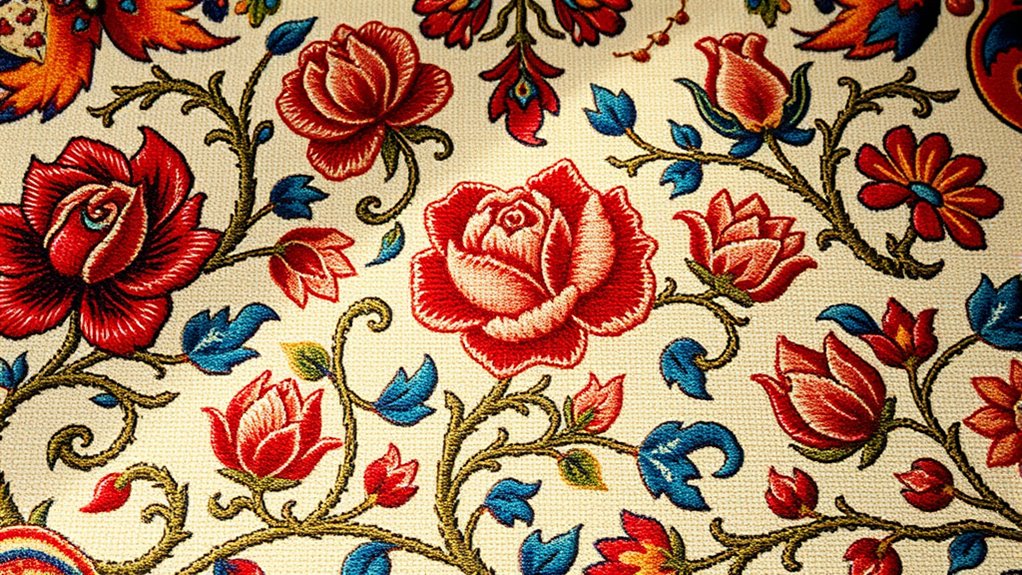
Floral motifs in Persian carpets are more than decorative elements; they embody deep cultural and spiritual meanings that reflect the values and beliefs of the societies that created them. You’ll notice that botanical symbolism often represents ideals like paradise, renewal, and divine beauty. These motifs serve as visual expressions of spiritual significance, connecting everyday life to religious concepts. For example, certain flowers symbolize eternal life or spiritual enlightenment, reinforcing cultural identity and faith. By incorporating these symbols, Persian artisans communicate shared values and spiritual aspirations. When you observe these intricate patterns, you’re engaging with a rich tradition that intertwines art, religion, and cultural identity—highlighting how floral motifs transcend mere decoration to embody profound cultural narratives.
Tips for Analyzing and Appreciating Floral Designs in Persian Carpets

To truly appreciate the beauty and meaning of floral designs in Persian carpets, start by observing the overall pattern and how individual motifs interact within the composition. Focus on the flow of floral artistry and note recurring elements that reveal botanical symbolism. Pay attention to color choices and placement, which often convey specific meanings. Use this table to guide your analysis:
| Aspect | What to Observe |
|---|---|
| Pattern Layout | Symmetry, repetition, or asymmetry |
| Motif Interaction | How flowers connect or overlap |
| Color Significance | Emotional tone and symbolic meanings |
| Symbolic Elements | Hidden or traditional botanical symbols |
This approach helps deepen your understanding of the craftsmanship and cultural nuances behind each carpet.
Frequently Asked Questions
How Do Floral Motifs Evolve Over Different Persian Dynasties?
You notice that floral motifs in Persian carpets change markedly over different dynasties, reflecting evolving botanical symbolism and design trends. During the Safavid era, motifs become more intricate, symbolizing paradise and divine beauty. In later periods, designs simplify or stylize, emphasizing artistic innovation. These shifts show how Persian artisans adapt floral symbolism, influencing the design evolution of carpets, and mirroring broader cultural and spiritual values across dynasties.
Are Specific Flowers Linked to Particular Persian Tribes or Communities?
Imagine floral motifs as whispers of tribal symbolism and regional floral styles, each flower echoing a community’s unique identity. You’ll find specific flowers linked to particular Persian tribes or regions, like the pomegranate representing fertility or the lotus symbolizing purity. These motifs serve as cultural signatures, revealing the stories and values of diverse communities woven into each carpet, making each piece a vibrant tapestry of history and identity.
Can Floral Patterns Indicate the Carpet’S Geographic Origin Precisely?
You might wonder if floral patterns can reveal a carpet’s exact origin. While botanical symbolism and cultural significance influence floral motifs, they don’t provide a precise geographic marker. Different regions share similar designs, and motifs often blend influences. So, although floral patterns can suggest a general area or cultural background, they don’t allow you to determine the exact origin of a Persian carpet definitively.
How Do Floral Motifs Relate to Persian Poetry and Literature?
Imagine floral motifs as pages from a Persian poet’s notebook, each symbol carrying poetic symbolism and layered meanings. You see, these patterns aren’t just decoration; they embody symbolic meanings drawn from Persian poetry and literature. Floral motifs serve as visual allegories, whispering stories of love, paradise, and divine beauty. By understanding their poetic symbolism, you decipher a deeper connection to Persian culture, where every flower reflects a verse in the timeless poetry of the land.
What Are Common Myths or Stories Behind Certain Floral Symbols?
You might wonder about the myths behind floral symbols, and many carry rich symbolic meanings rooted in mythological stories. For example, the lotus often represents purity and spiritual awakening, tied to ancient stories of rebirth. The rose symbolizes love and passion, linked to romantic legends. These symbols convey deeper cultural messages, and understanding their mythological backgrounds helps you appreciate the artistic and spiritual significance woven into Persian carpets.
Conclusion
By understanding the floral motifs in Persian carpets, you unveil a garden of stories woven into each design. These patterns are like a secret language, revealing cultural, spiritual, and regional tales. As you appreciate their intricate details, remember that each flower is a petal in a larger masterpiece—your journey through Persian art blooms with deeper meaning and connection. Embrace these motifs, and let their beauty blossom within your understanding.
